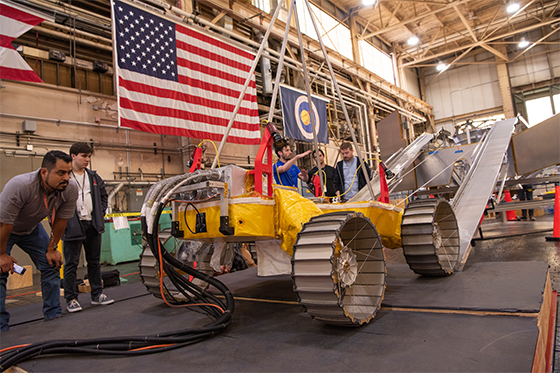
NASA’s VIPER team practiced driving the rover down Griffin’s sizeable ramps to mimic safely egressing onto the lunar surface. Watch here!
June 16, 2022, Pittsburgh, PA – NASA and Astrobotic completed egress, or exit, testing with prototypes of NASA’s water-hunting Volatiles Investigating Polar Exploration Rover (VIPER) and Astrobotic’s Griffin lunar lander. During testing at NASA’s Glenn Research Center in Cleveland, VIPER was driven down Griffin’s sizeable ramps in simulated lunar surface situations to prove safe egress after landing on the Moon.
The largest lunar lander since Apollo’s lunar module, Griffin will precisely land near the Nobile Crater at the Moon’s south pole and deploy ramps for VIPER to drive off the lander. Griffin is equipped with ramps on both sides of its deck, providing VIPER with options for safely exiting onto the Moon’s surface. Griffin is also relying on Astrobotic’s market-leading landing sensors to locate the optimal landing site with the best lighting, safest rock distribution, and lowest slope possible.
The teams tested many landing configurations, including average and worst-case inclines and large, obstructive obstacles like boulders. Griffin’s ramps were angled up to 33 degrees, in varied tip and roll positions.
“These egress tests prove that Griffin will safely deploy VIPER to the lunar surface and begin its important mission to locate water-ice on the Moon,” said Pete Frye, Astrobotic’s Mechanical and Fluid Systems Manager. “Griffin is also equipped with Astrobotic’s advanced Terrain Relative Navigation (TRN) landing tech, ensuring a safe and precise landing to maximize the science that can be accomplished.”
Testing will continue in the Simulated Lunar Operations (SLOPE) Laboratory at NASA’s Glenn Research Center in Cleveland and at Astrobotic’s headquarters in Pittsburgh, Pennsylvania. After testing, the final flight vehicle will be built and “acceptance” tested under various environmental conditions mimicking launch, transit, and surface scenarios. Griffin will then be shipped to the Cape Canaveral to integrate with the VIPER flight unit, and prep for launch.
After launching aboard a SpaceX Falcon Heavy rocket, Griffin will deliver VIPER to the lunar surface in late 2023 as part of NASA’s Commercial Lunar Payload Services (CLPS), under the Artemis program.

